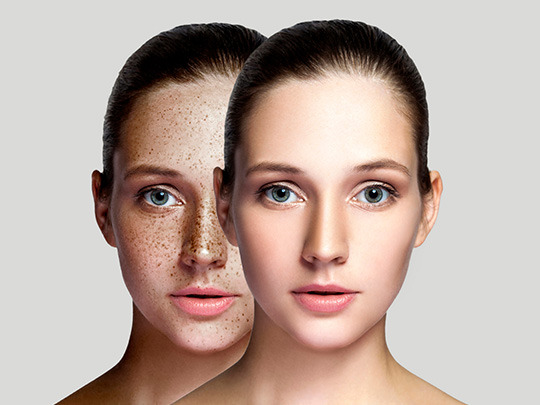#Pigmentation
Explore tagged Tumblr posts
Text
Pigmentation is multifactorial and not something anyone really should deal with for a lower-level biology course.
You can do the math really easily though: brown is always 75%, meaning it has complete dominance. The Punnett square would be BB, BB, BB, BB with only 1/4 exhibiting blue eyes. If you have a gene for brown, your eyes are brown — that’s complete dominance. No half-brown half-blue mixing or anything (incomplete dominance or codominance). Easy.
6.25 is 1/4 of 25, so for the second generation, green is completely recessive to blue by the same logic. The question then becomes where the genes are located, and it is too late at night for me to want to deal with multiallele traits when one trait doesn’t even show up until the third generation.
*oh since the question was method of inheritance — brown dominant to blue dominant to green. We’re not given the proportions based on sex and I’m assuming this is all for one gene and not two so I can’t say beyond that. Past my pay grade*
Going into this bio exam knowing brown eyes are dominant, blue eyes are submissive, and that punettes are square. Wish me luck!
#biology#pigmentation#inheritance#pigmentation and inheritance are way more complicated but I can’t be bothered right now
28K notes
·
View notes
Text
What is Eczema and how to cure it?

Learn about eczema, its causes, symptoms, and effective treatments, including home remedies and medical solutions for relief.
2 notes
·
View notes
Text

Skin♥️
5 notes
·
View notes
Text
Say goodbye to the harmful chemicals and join the power of nature together with our handmade oil-based serum! Through this "100% organic oils" Indian-made product, luxurious formulations are designed that are suitable for all skin types including both men and women. Packed with a potent blend of natural essential oils, including 2% hyaluronic acid to make your skin look young and fresh and Vitamin ACE for its skin overall health, reduces the sign of aging, this serum nourishes, protects, and revitalizes your skin without any harmful additives. Experience the difference nature can make – embrace a healthy, glowing complexion with the power of plants!
2 notes
·
View notes
Text
Face masks have become an essential personal protection equipment in the wake of the COVID-19 outbreak. Face masks are becoming more and more popular, therefore choosing the correct manufacturer is essential to guaranteeing quality.
Visit:- Essential Factors to Consider When Selecting Face Mask Manufacturers?
#facewash#haircareproducts#soaps#beautygel#facemask#hairmask#facecream#bodywash#migraine#Pigmentation#acne#DistributorsWanted#Distributorship#new#BrandAwareness#business#go4distributors
3 notes
·
View notes
Text

What You Need to Know About Skin Care After Sun Exposure
Sun exposure can have both positive and negative effects on your skin. On one hand, it can provide vitamin D, boost your mood, and enhance your appearance. On the other hand, it can also cause sunburn, premature aging, and skin cancer. Therefore, it is important to know how to protect your skin from the sun and how to take care of it after sun exposure.
How to Protect Your Skin from the Sun
The best way to protect your skin from the sun is to avoid excessive sun exposure, especially between 10 a.m. and 4 p.m., when the sun's rays are the strongest. However, if you have to go outside during these hours, you should follow these tips:
- Wear sunscreen with at least SPF 30 and broad-spectrum protection, which can block both UVA and UVB rays. UVA rays can penetrate deeper into the skin and cause wrinkles, sagging, and dark spots. UVB rays can damage the surface of the skin and cause sunburn and skin cancer. You should apply sunscreen 15 to 30 minutes before going outside and reapply every two hours or after sweating or swimming.
- Wear protective clothing, such as long-sleeved shirts, pants, hats, and sunglasses. You can also look for clothes with UPF (ultraviolet protection factor), which can indicate how much UV radiation can pass through the fabric. The higher the UPF, the better the protection. For example, a shirt with UPF 50 can block 98% of UV rays.
- Seek shade whenever possible, such as under trees, umbrellas, or awnings. However, keep in mind that shade does not provide complete protection, as UV rays can still reflect from the ground, water, or sand. Therefore, you should still wear sunscreen and clothing even if you are in the shade.
- Avoid artificial tanning, such as tanning beds, lamps, or booths. These devices can emit UV rays that are even more intense than the sun and can increase your risk of skin cancer and aging. If you want to have a tan, you can opt for safer alternatives, such as self-tanning products or spray tans.
How to Take Care of Your Skin After Sun Exposure
Even if you follow the above tips, you may still experience some degree of sun damage after being outside. This is because the sun can affect your skin in various ways, such as:
- Dehydrating your skin, which can make it dry, flaky, and tight. This can also impair your skin's barrier function, which can make it more vulnerable to infections and irritants.
- Inflaming your skin, which can cause redness, swelling, pain, and itching. This can also trigger the production of free radicals, which are unstable molecules that can damage your skin cells and DNA.
- Pigmenting your skin, which can cause tanning, freckles, or dark spots. This is a result of your skin producing more melanin, which is a pigment that can protect your skin from further sun damage. However, too much melanin can also cause uneven skin tone and hyperpigmentation.
- Aging your skin, which can cause wrinkles, sagging, and loss of elasticity. This is a result of your skin breaking down collagen and elastin, which are the proteins that give your skin its structure and firmness.
To minimize these effects and help your skin recover after sun exposure, you should follow these tips:
- Wash your skin gently with a mild cleanser and lukewarm water. This can help remove any dirt, sweat, or sunscreen residue from your skin and prevent clogged pores and breakouts. Avoid using harsh soaps, scrubs, or hot water, as they can irritate your skin and strip away its natural oils.
- Moisturize your skin generously with a hydrating lotion or cream. This can help replenish the moisture that your skin lost from the sun and restore its barrier function. Look for moisturizers that contain soothing and healing ingredients, such as aloe vera, chamomile, oatmeal, or green tea. Avoid moisturizers that contain alcohol, fragrance, or retinoids, as they can dry out or sensitize your skin.
- Cool your skin with a cold compress, ice pack, or damp cloth. This can help reduce the inflammation, pain, and itching that your skin may experience after sun exposure. You can also use products that contain cooling and anti-inflammatory ingredients, such as menthol, cucumber, or calamine. Avoid applying ice directly to your skin, as it can cause frostbite or damage your blood vessels.
- Treat your skin with products that can repair the sun damage and prevent further harm. For example, you can use products that contain antioxidants, such as vitamin C, vitamin E, or niacinamide, which can neutralize the free radicals and brighten your skin tone. You can also use products that contain ingredients that can stimulate collagen and elastin production, such as peptides, growth factors, or retinol. However, be careful with using products that can make your skin more sensitive to the sun, such as alpha hydroxy acids, beta hydroxy acids, or benzoyl peroxide. You should use them at night and always wear sunscreen during the day.
- Hydrate your body internally by drinking plenty of water and fluids. This can help replenish the water that your body lost from sweating and prevent dehydration, which can affect your skin and overall health. You can also eat foods that are rich in water, such as fruits, vegetables, soups, or smoothies. Avoid drinking alcohol, caffeine, or sugary drinks, as they can dehydrate your body and worsen your skin condition.
Conclusion
Sun exposure can have both positive and negative effects on your skin, depending on how much and how often you expose yourself to it. To protect your skin from the sun and take care of it after sun exposure, you should follow the tips mentioned above and consult your dermatologist if you have any concerns or questions. By doing so, you can enjoy the benefits of the sun while minimizing its risks and keeping your skin healthy and beautiful.
#sun exposure#skin care#sun protection#sunburn#hydration#inflammation#pigmentation#aging#antioxidants#collagen#elastin
2 notes
·
View notes
Text

Pigmentation Skin Treatment | Best Skin Treatment For Pigmentation (vcareskinclinic.com)
#pigmentation treatment#hyper pigmentation treatment#pigmentation#pigmentation skin treatment#skin pigmentation#skin treatment#skin clinic#skin care clinic#skin pigmentation treatment
3 notes
·
View notes
Text

Unlock the Secrets to Radiant Skin! Dive into the world of pigmentation with me, your friendly dermatologist! Discover the causes, solutions, and your path to flawless skin. Join me on this journey to #SkinConfidence at Dr.Praneeth Clinic
1️⃣ Sun Exposure:
Excessive sun exposure can lead to issues like sunspots and freckles. Protect your skin with SPF 30+ sunscreen, seek shade, and consider sunless tanning for a safe glow.
2️⃣ Genetics:
Family history can influence pigmentation. Knowing your genetic risk helps tailor skincare and dermatologist consultations.
3️ Hormonal Changes:
Hormonal shifts, like pregnancy or birth control use, can trigger melasma. Consult a dermatologist for personalized guidance.
4️ Post-Injury:
Injuries, even acne, can cause pigmentation. Treat them gently and consider scar-minimizing products.
5️ Certain Medications:
Some medications, such as antibiotics, may induce pigmentation. Consult your healthcare provider if skin changes occur during treatment.
Book Your Initial Consultation Today at 𝑫𝒓.𝑷𝒓𝒂𝒏𝒆𝒆𝒕𝒉 𝑪𝒍𝒊𝒏𝒊𝒄
Visit - www.drpraneethclinic.com
Call - 9704946534/040-48553939
Address: JB Shashi Arcade, 2nd Floor, JNTU Rd, KPHB.
#skin#skincare#skinclinic#skinhealth#skinboosters#skincaretips#skincareproducts#pigmentation#pigmentationremoval#pigmentationsolution#pigmentationtreatment#beautyskin#beautyskintips#beautyskincare#drpraneeth#drpraneethclinic#drpraneethclinicinkukatpally#KPHB#kphb#kphbcolony#hyderbaad#hyderbad
2 notes
·
View notes
Text
Moisturizer With Hyaluronic Acid - Shop Online at Uniqaya.Com



Hydrate and plump your skin with Uniqaya’s Moisturizer with Hyaluronic Acid. Lightweight, non-greasy formula delivers intense moisture for a smooth, radiant complexion. Shop online now at Uniqaya.com!
#uniqaya#uniqayalifestyle#naturalskincare#facewash#skincareaddiction#vitaminc#vitamincglow#foamingfacewash#skincareproduct#skincaregoals#naturalskincarelovers#madeinindia#footcarecream#explorepage#explorereel#retinol#pigmentation#retinolskincare#retinolserum#retinolcream#pigmentedskin#retinoid#sensitiveskin#retinolskinbrightener#dailyskincare#pigmentationremoval#pigmentationtreatment#nightcream#nightrepair#nightcreammsglow
0 notes
Text
Reveal Radiant Skin with Expert Skin Lightening Treatment in Mumbai at Cara Clinic
Looking for a safe and effective skin lightening treatment in Mumbai? Cara Clinic offers advanced dermatological solutions to help you achieve an even-toned, radiant complexion. Whether you're battling hyperpigmentation, melasma, sunspots, or dull skin, our expert dermatologists create customised treatment plans tailored to your unique skin needs.

At Cara Clinic, we believe in enhancing your natural beauty through clinically proven and dermatologist-approved procedures. Our skin lightening treatment is performed in a safe, hygienic, and comfortable environment.
Located in the heart of Mumbai, Cara Clinic stands out for its cutting-edge technology, personalised care, and a strong focus on visible results. The treatment is designed to reduce excess melanin, promote cell renewal, and improve overall skin clarity without compromising skin health.
What makes us the go-to clinic for skin lightening in Mumbai? It's our commitment to quality, transparency, and client satisfaction. Our qualified dermatologist, Dr. Aleena Rehman, provides in-depth consultations to understand your skin goals and recommend the best course of action for long-lasting radiance.
Don’t let pigmentation or uneven skin tone affect your confidence. Choose Cara Clinic—Mumbai’s trusted name in advanced skin care—to glow with confidence and grace.
Book your appointment today and experience the difference with Cara Clinic’s expert skin lightening solutions.
0 notes
Text
Which Cream Is Best For Cracked Foot

Your feet called & they’re begging for a glow-up. And no sis, coconut oil alone isn’t cutting it. If your cracked heels feel like they’ve walked through the apocalypse—it’s time to level up and shop foot cream online that actually delivers. Let’s talk about Uniqaya Foot Care Cream—a total game-changer in the foot care universe. No fluff, no fake promises—just a hardcore hydration formula that fixes cracks, revives tired soles, and makes you fall in love with your feet again.
So, what makes this the best cream for cracked foot drama? Let’s break it down:
Coffee Extract – Yup, your latte’s got competition. Coffee isn’t just for Monday mornings but it’s a powerhouse antioxidant that boosts circulation and fades dullness. It brings your feet back to life.
Peppermint Oil – Peppermint calms inflammation, killing odor-causing bacteria, and giving your feet a breath of fresh air.
Urea – The OG of hydration. It draws moisture into the skin like a magnet and keeps it locked in. So say Bye-bye to dry patches.
Shea Butter – Thick, creamy, and ultra-nourishing. It’s just like wrapping your heels in a buttery hug that softens and smoothens the rough edges.
So if you’re looking for the best cracked foot cream that’s equal parts luxurious and legit—Uniqaya’s Foot Cream is your perfect match for that. Your feet don’t need filters—they need this.
Cracked heels? Healed.
Tired soles? Energized.
Ashy ankles? Not today.
Shop foot cream online and slay footcare the Gen Z way.
#foot care moisturizer#foot care cream#foot cream#krack heel repair cream#best foot care cream#foot moisturizer#heel care cream#foot whitening cream#foot crack cream#foot cream for cracked heels#Shop foot care moisturizer#Dry and cracked heels#uniqaya#uniqayalifestyle#naturalskincare#facewash#skincareaddiction#vitaminc#vitamincglow#foamingfacewash#skincareproduct#skincaregoals#naturalskincarelovers#madeinindia#footcarecream#explorepage#explorereel#retinol#pigmentation#retinolskincare
0 notes
Text

VCare Skin Whitening Soap – Effective Pigmentation Removal with Natural Brightening Power
Struggling with pigmentation, dark spots, or uneven skin tone? VCare Skin Whitening Soap is your go-to solution for visibly reducing pigmentation caused by sun exposure, hormonal changes, or acne scars. Enriched with 12 powerful natural ingredients like Turmeric, Kasturi Manjal, Aloe Vera, Lemon Oil, and Papain, this soap works deep into your skin to lighten blemishes and remove sun tan while preventing future pigmentation.
The unique blend of Saffron and Turmeric not only brightens your skin but also promotes an even, radiant complexion. Safe for all skin types and gentle enough for daily use, it’s the perfect skincare essential for both men and women looking to regain clear, spotless skin.
Say goodbye to patchy, pigmented skin and hello to a naturally glowing look—every day!
#pigmentation#sundamage#darkspots#sunexposure#skinirritation#hyperpigmentation#skinwhiteningsoap#skincare#naturalsoap
0 notes
Text
Tips To Prevent Pigmentation From Getting Worse?
Pigmentation is a common skin concern that affects people of all ages and skin types. Whether it’s due to sun exposure, hormonal changes, acne scars, or genetic factors, pigmentation issues can lead to uneven skin tone, dark spots, and blemishes. While pigmentation is not harmful, it can impact one’s appearance and cause frustration. If you are someone struggling with pigmentation and have no idea what to do, then you have landed on the right page. This blog brings top tips to prevent pigmentation from getting worse from the clinic offering the best pigmentation treatment in Delhi. Stay Tuned to know more!

Tips To Prevent Pigmentation From Getting Worse

Here are expert tips to prevent pigmentation from getting worse:
Protect Your Skin from the Sun
Sun is the main culprit of making pigmentation worse. This is because UV rays from the sun stimulate melanin production in the skin. This eventually causes existing dark spots or pigmentation to become darker. In case of unprotected and prolonged exposure, it can also lead to the formation of new pigmentation over time.
Incorporate Skin Brightening Ingredients in Your Skincare Routine
Incorporating skin-brightening ingredients in your skincare routine can help reduce hyperpigmentation. These products work by preventing the development of dark spots. Examples of such ingredients include vitamin C, Niacinamide, Alpha Arbutin, retinoids, and licorice extract.
Be Consistent with Your Skincare Routine
Skincare might work magically but it’s definitely not magic. Thus, the key to making skincare work like magic is consistency. Being consistent with your skincare routine prevents it from getting worse and helps fade it gradually.
Avoid Picking or Scratching Your Skin
Another most important tip to prevent pigmentation from getting worse is to avoid picking at acne, blemishes or any existing spots. This is because picking at the acne or acne marks can result in post-inflammatory hyperpigmentation, which is even more stubborn to treat. In addition, in severe cases, these scars can even become permanent. Thus, avoid picking up acne or blemishes, preventing pigmentation from getting worse.
Get expert consultation from the Best Dermatologist for managing Pigmentation!
Pigmentation can be a stubborn skin issue, but with the right care and preventive measures, you can keep it from worsening and even reduce its appearance. By incorporating sun protection, gentle skincare practices, brightening ingredients, and regular exfoliation into your routine, you’ll be well on your way to achieving clear, even-toned skin. If you are struggling with pigmentation, get expert consultation from the best dermatologist in Delhi only at Delhi Wellness Clinics. From chemical peels to lasers to anti pigmentation peels they offer various treatments that help one to get their flawless skin back.

To know more, book an appointment at Delhi Wellness Clinics today!
Original Source:- https://delhiwellnessclinic.wordpress.com/2025/04/10/tips-to-prevent-pigmentation-from-getting-worse/
#pigmentation#Tips To Prevent Pigmentation#pigmentation treatment in Delhi#best dermatologist in Delhi#Delhi Wellness Clinics
0 notes
Text
Ace Oil for Pigmentation: Glow Up Your Skin

Struggling with pigmentation and uneven skin tone? Discover the power of face oils in combating dark spots and restoring your skin’s natural radiance. This guide delves into the best face oils for pigmentation, including the renowned Kumkumadi oil, known for its brightening and nourishing properties. Learn about the causes of pigmentation, how face oils penetrate deep into the skin, and why they are packed with antioxidants, vitamins, and essential fatty acids. Whether due to sun exposure, hormonal changes, or inflammation, face oils offer a natural and effective solution for achieving a luminous, even-toned complexion. Say goodbye to pigmentation and hello to glowing skin with the right face oil!
#FaceOil#Pigmentation#Skincare#GlowingSkin#KumkumadiOil#NaturalBeauty#DarkSpots#AyurvedicSkincare#HealthySkin#BeautyTips
0 notes